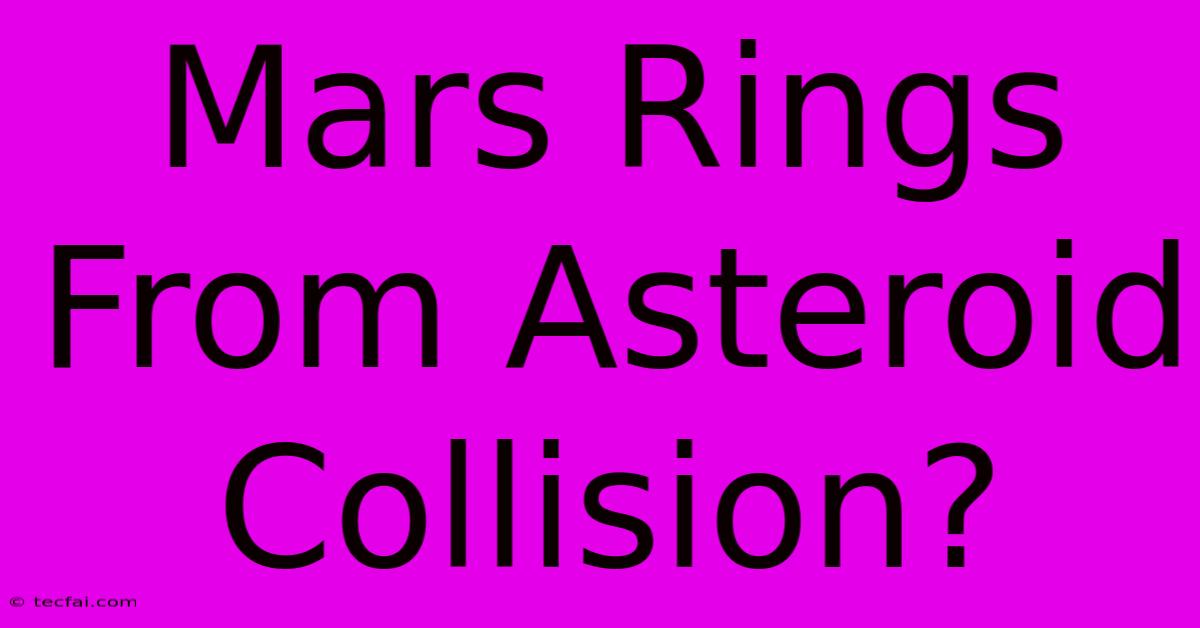Mars Rings From Asteroid Collision?

Discover more detailed and exciting information on our website. Click the link below to start your adventure: Visit Best Website tecfai.com. Don't miss out!
Table of Contents
Mars Rings: A Hypothetical Spectacle from an Asteroid Collision?
The mesmerizing rings of Saturn are a celestial wonder, a breathtaking display of icy particles orbiting the gas giant. But what if Mars, our rusty neighbor, sported a similar spectacle? While currently ringless, the possibility of Mars acquiring rings through a catastrophic asteroid collision is a fascinating area of scientific speculation. This article delves into the hypothetical scenario, exploring the conditions necessary for ring formation and the potential implications for Mars's future.
Could an Asteroid Collision Create Martian Rings?
The prevailing theory suggests that many planetary rings, including Saturn's, originated from the disintegration of moons or asteroids. A significant asteroid impact on Mars could potentially create a similar scenario. Here's how it could work:
-
The Impact: A sufficiently large asteroid, perhaps tens or even hundreds of kilometers in diameter, would need to collide with Mars at a specific trajectory. A direct hit wouldn't necessarily create rings; a glancing blow, shattering the asteroid and ejecting a substantial amount of material into orbit, is more likely.
-
Debris Cloud: The impact would send a massive cloud of debris – rock, dust, and ice (if any exists on Mars) – into orbit around the planet. The size and distribution of this debris cloud would be crucial in ring formation.
-
Orbital Dynamics: Gravity plays a vital role. For rings to be stable, the debris must remain within a specific orbital zone. Too close to Mars, and the material would spiral down and eventually impact the planet's surface. Too far out, and the particles would disperse, failing to coalesce into a cohesive ring structure.
-
Ring Stability: The longevity of Martian rings would depend on several factors, including the size and composition of the debris, the gravitational influence of Mars's moons (Phobos and Deimos), and the presence of any atmospheric drag. Unlike Saturn's icy rings, which are relatively stable, Martian rings – composed mostly of rock and dust – might be less durable, potentially decaying over geological timescales.
Evidence (or Lack Thereof)
Currently, there is no direct observational evidence supporting the existence of past or present Martian rings. However, the absence of evidence isn't necessarily evidence of absence. The possibility remains open, and future missions, with advanced imaging technology, may uncover subtle clues hinting at a past ring system. Analyzing the composition and distribution of Martian meteorites could also offer indirect evidence of past impacts and potential ring formation.
Implications for Future Mars Exploration
The hypothetical existence of Martian rings adds another layer of complexity to future Mars exploration. The presence of a ring system could affect the trajectory and stability of spacecraft orbiting Mars. Furthermore, the debris within the rings could pose a hazard to landers and rovers, requiring advanced mitigation strategies.
Beyond Rings: Other Asteroid Impact Scenarios
It's important to remember that asteroid impacts can have far-reaching consequences, extending beyond the possibility of ring formation. A significant impact could drastically alter Mars's climate, atmosphere, and geological structure, potentially even leading to the extinction of any extant life. Studying the history of asteroid impacts on Mars is crucial to understanding the planet's evolution and its potential for habitability.
In conclusion, while the idea of Mars sporting a magnificent ring system remains hypothetical, it's a compelling thought experiment that underscores the dynamic nature of our solar system and the potentially dramatic consequences of asteroid collisions. Future research and exploration may one day reveal whether this hypothetical scenario ever became a reality.

Thank you for visiting our website wich cover about Mars Rings From Asteroid Collision?. We hope the information provided has been useful to you. Feel free to contact us if you have any questions or need further assistance. See you next time and dont miss to bookmark.
Featured Posts
-
Brazil Bolsonaros Legal Status
Nov 26, 2024
-
Matchday Menu Seedorfs Ucl Debut
Nov 26, 2024
-
Ladbroke Grove Double Shooting Updates
Nov 26, 2024
-
Harbowl John Harbaughs Crucial 4th Down Decision
Nov 26, 2024
-
Psg Vs Bayern Difficult Matchup
Nov 26, 2024
